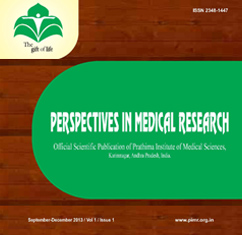
Original Article
Year : 2017 | Volume : 5 | Issue : 1 Page : 46 - 49
Amith Kumar Ch1, Ch Sahay2, Mounika Krishna3, Sowmithra4
1Associate Professor,2Senior Resident,3,4Junior Resident, Department of Paediatrics, Prathima Institute of Medical Sciences, Karimnagar, Telanagana, India.
Address for correspondence: Dr Amith Kumar Ch, Associate Professor, Department of Paediatrics, Prathima Institute of Medical Sciences, Karimnagar, Telanagana, India.
Email: dramithch@gmail.com
Introduction: Retinopathy of prematurity (ROP) or retrolental fibroplasia as it was originally named,has had a most curious life span as a twentieth century disease.These out breaks of the disease occurred approximately 25 years apart in the mid 1950s and late 1970s. Retinopathy of prematurity is becoming a major cause of potentially preventable blindness among children in middle income countries that have introduced neonatal intensive care units for preterm and low birth weight babies.
Aims and Objective :So the present study helps to determine the incidence of retinopathy of prematurity in neonates and to determine its association with certain risk factors.
Materials and Methods :It is a clinical study of all neonates with a gestational age less than 36 weeks and /or a birth weight of less than 2000gms at Prathima Institute of Medical Sciences,Karimnagar for a period 2years. Neonates were evaluated through detailed clinical history, detailed anterior segment examination and indirect ophthalmoscopy after full dilatation of pupils.
Results :Of the 100 neonates screened, 53 were males (53 %) and 47 were females (47%). Among the neonates who developed ROP, 23 were males (51.11%) and 22 were females (48.88%). Incidence of ROP among male and female babies is nearly equal and no statistically significant correlation could be found.Of the 45 neonates who were found to have ROP, 13 neonates were in stage 1 (28.88%), 16 in stage 2 (35.55%), 13 in stage 3 (28.88%), 2 in stage 4 (4.44%) and 1 in APROP stage of the disease. 12 infants had plus 42.05%.
Conclusion : The incidence of ROP in the present study was 42.05% for any stage of which 62.22% were in stage 1 or 2 of the disease. The incidence of ROP showed a significant statistical correalation with prematurity, low birth weight, RDS, supplemental oxygen, blood transfusion, and injection betamethasone to mother. Injection betamethasone to the mother has a significant protective effect on the development of ROP.
Keywords : Retinopathy of prematurity, low birthweight,neonates.

Open Access
Perspectives in Medical Research is committed to keeping research articles Open Access.Journal permits any users to read, download, copy, print, search, or link to the full texts of these articles...
Read more
